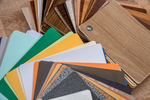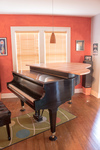We may receive a commission when you use our affiliate links. However, this does not impact our recommendations.
https://youtu.be/evkW6Hqei-0
Video: How I use a grid system to make digital woodworking easier
CNCs are wonderful machines. For woodworkers who want to combine traditional woodworking with digital techniques, they can do all kinds of useful tasks. But, they can be challenging tools to master. Certainly, the technology is intimidating for some, but even if it’s not, I’ve found that some of the everyday tasks you do to prepare, set up, align and hold the wood to be ongoing challenges.
Positioning, aligning, registering and holding parts
Sure, wood is not as difficult to machine as metal, but cutting wood on a CNC is not as simple as you’d think. Wood machines fine once you learn how to mix a combination of bits, spindle speed, and feed rates. It’s all the other challenges that keep you on your toes. Wood is thick, relatively large, a lot of mass and weight and the physics challenges that come with it. Add that it’s slick and really wants to move while being cut.
As pointed out in my first Popular Woodworking article and earlier blog posts, the positioning, registration, aligning parts and holding wood to a CNC’s bed that are among the most serious challenges to digital woodworkers. They may be deceptively simple tasks, but dealing with them involve a combination of engineering, design and physics challenges to overcome. And, it never stops. It’s ongoing and their is no single soluton that fits every situation. As long as you’re using a CNC, you’ll wrestle with these issues constantly. Though I began using CNCs nearly twenty years ago, I still have to think carefully about aligning, positioning and part holding on every project.
Grid systems to the rescue
The good news is there is a solution that eliminates about 90% of these daily challenges. It involves a special CNC grid system optimized for digital woodworking tasks that you can create on your CNC.
Grids are are not as simple as you might think. It’s a broad topic and in the future, I’ll follow up with posts on grid concepts, grid designs, and a few suggested solutions. But today, it’s time for an introduction. I’ve made a short video about the grid system I use on my own custom CNC.
In the future, I’ll explain the benefits of different grid designs, bed layouts, positioning tricks, clamping methods, and other ways you can modify your own CNC. I’ll include solutions for different kinds of CNC setups: CNCs with T-track beds, mixed T-track + spoil board beds, one-piece beds and share plans and solutions for specific CNCs including the Laguna IQ and Axiom Precision CNCs, and the Shapeoko XL or XXL CNCs.
Related Posts
- Home Position See my CNC in action
- About my Custom CNC
Additional Resources
- Digital Woodworking on Instagram
- Personal Work on Instagram
- Digital Woodworking YouTube Channel
Here are some supplies and tools we find essential in our everyday work around the shop. We may receive a commission from sales referred by our links; however, we have carefully selected these products for their usefulness and quality.









